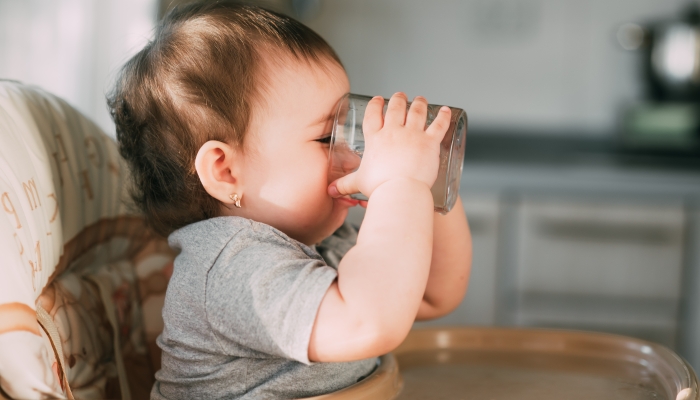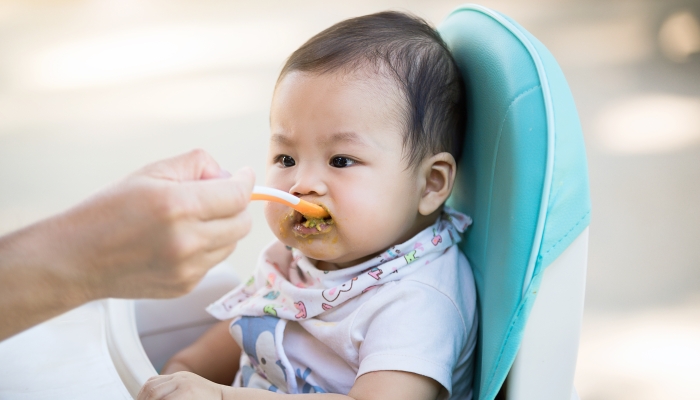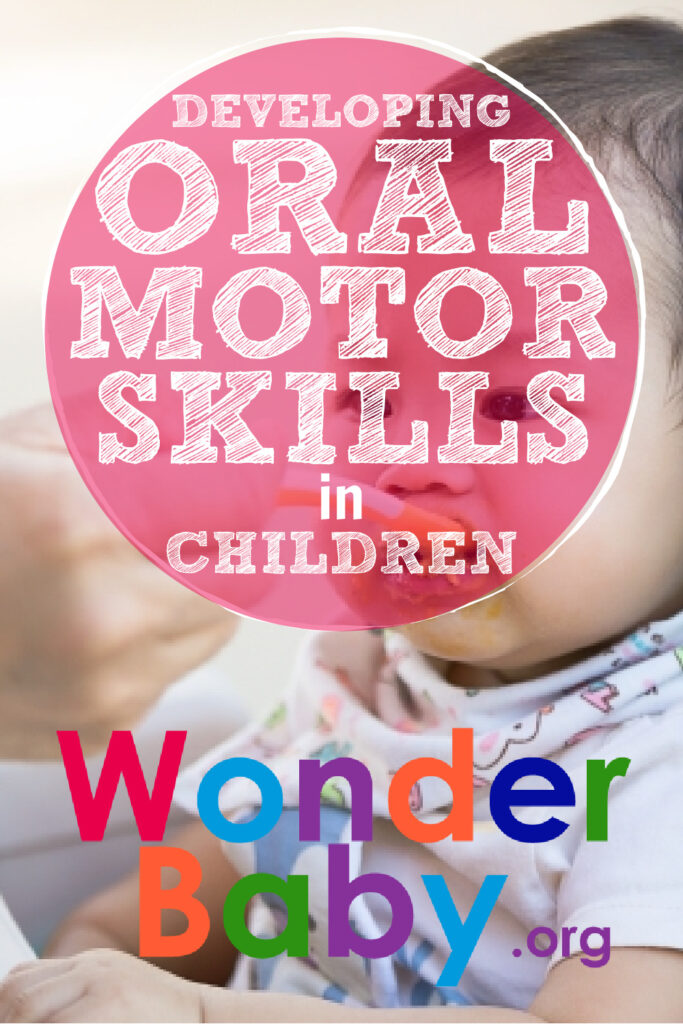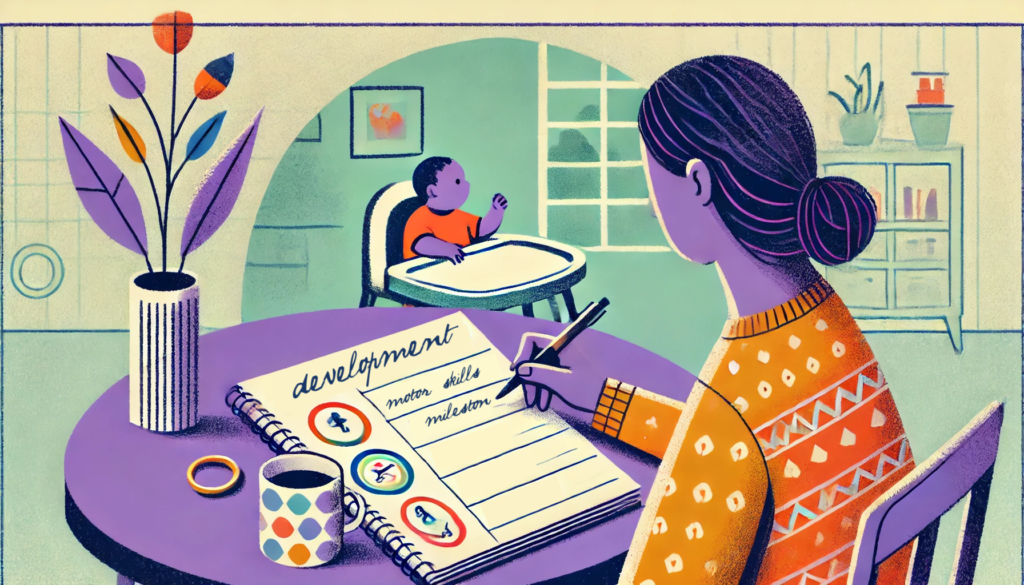Developing Oral Motor Skills in Children

- Oral motor skills refer to the functions of the tongue, lips, jaw, cheeks, and the hard and soft palate.
- During the third trimester, a baby begins to practice the oral motor skills necessary for life outside the womb. Inside they are developing the muscle strength to suck, swallow, bite and breathe.
- Everyday activities such as chewing, swallowing, and speaking require proper oral motor development.
It’s finally time to feed your little one their first solid food! You get a spoonful of banana baby food ready to go and eagerly place it in their mouth. They seem to enjoy the flavor, but much to your dismay, your baby’s tongue pushes half of it back out.
What’s going on? Shouldn’t your baby be able to pull their food in and swallow? Well yes, but not right away.
When it’s time to eat, your child uses a range of oral motor skills to bite, chew, and swallow. These very motions are the same ones responsible for speech production. Oral motor skills are a significant part of childhood development and take time to develop.
Children need to develop strong oral motor skills to be able to speak clearly and correctly. The development of these skills begins in infancy and continues throughout childhood.
Curious about the developmental milestones of oral motor skills? We’ll break down the ages and stages of oral motor skills development and help you identify any possible red flags in your child’s development.
What Are Oral Motor Skills?
Oral motor skills refer to the functions of the tongue, lips, jaw, cheeks, and the hard and soft palate. Though it may seem like a small portion of your child’s development, these skills are crucial to your child’s well-being.
Proper oral development enables your child to chew, lick, suck, speak, and swallow. These are also the same skills responsible for facial expressions.
A step further, oral skills can even help your child digest food properly. When properly chewed, food is mixed with digestive enzymes in the mouth, aiding in the breakdown.

Stages of Oral Motor Development
Oral motor development takes place throughout the first two years of a child’s life. Each stage brings a new set of skills being developed and practiced.
In the Womb
Have you ever watched a newborn attach to the breast or bottle for the first time? It’s as if they took a class in the womb on how to eat. Most children come out of the womb with an innate desire to find milk, suck, and swallow.
Well, behind the scenes, there is a sort of “class” going on in the womb. During the third trimester, a baby begins to practice the oral motor skills necessary for life outside the womb. Inside they are developing the muscle strength to suck, swallow, bite and breathe.
There are also several reflexes their body is developing. This includes the gag reflex, rooting reflex, swallow reflex, transverse tongue reflex, phasic bite reflex, and the palmomental reflex. That’s a lot of development inside the womb!
Birth to 3 Months
This time frame is perhaps one of the most crucial stages for the development of your child’s oral motor skills, outside the womb. This is because voluntary eating habits developed in the first six weeks of life can determine whether a child will have eating difficulties later.
During this time frame, eating becomes less involuntary and more voluntary. This means your baby isn’t simply responding to stimuli of the bottle or breast. You may also notice your baby reaching their hand to the bottle now.
Your baby’s sweet voice will also emerge during this period in crying and vowel sounds. You will also get to see that precious smile.
3 to 7 Months of Age
This stage is an exciting one for many parents. By 4 months of age, some babies are ready for their first pureed food. They’re now developing the horizontal tongue and jaw movement as well as the munching ability they will need for eating food.
By now, your baby is also able to eat in an upright position. They might even begin to hold their bottle with two hands.
You will also begin to hear your little one babble in two syllables and smile and coo in delight.
7 to 9 Months of Age
During this stage, many babies are sitting up unassisted and crawling. When this happens, they develop the jaw stability needed to mash solid foods and the fine motor skills to pick up foods. They are also able to control their breathing while they eat.
New developments in their feeding skills include being able to move food side to side, close their lips, scrape food off a spoon with their lip, and chew in a circular motion. This is when your child can begin drinking out of a cup and trying new food textures including lumpy, soft foods.
The babbling of duplicated consonants also takes the stage during this period.
12 to 15 Months of Age
By this point, your baby has developed all the oral motor skills needed to be able to feed successfully. From now on, they’ll just be sharpening these skills by putting them to use. This means your baby is now ready to chew firmer foods like cheese and pasta.
Your child is also ready to drink from an open cup. At meal times, you’ll notice they are able to keep their lips closed when swallowing.
16 to 24 Months of Age
By now your child is likely chewing harder foods and gaining strength and confidence in self-feeding. Your child has also learned to form a bolus with their tongue as they eat. This bolus consists of the broken bits of food in their mouth.
This table will help clearly identify the developmental milestones at each age:
| Age | Oral Motor Skills Developed |
| In the Womb (3rd Trimester) |
|
| 0 to 3 Months |
|
| 3 to 7 Months |
|
| 7 to 9 Months |
|
| 12 to 15 Months |
|
| 16 to 24 Months |
|

Oral Motor Skills in Everyday Life
Oral motor skills are used frequently in a child’s life. Everyday activities such as swallowing and speaking require proper oral motor development.
For example, when a child takes a bite, the muscles in their mouth enable them to open wide enough for food. Proper oral motor development is crucial for their teeth, jaw, and tongue to work together to chew food. All parts must work in perfect coordination to prepare the food for swallowing.
As a child begins to speak, oral motor development is important in helping them form sounds. A child must have adequate tongue and jaw strength to execute sounds. Having the proper range of motion also impacts a child’s ability to speak clearly.
Symptoms of Oral Motor Problems
If you are concerned about your child’s oral motor development, a discussion with your child’s doctor will help. There are also several indicators that might help you decide if your child needs to be evaluated for oral motor developmental disabilities.
Talk to your child’s doctor if you notice any of the following:
- Weak suck
- Difficulty drinking from a straw
- Difficulty eating solid foods
- Food falling from child’s mouth
- Liquid dripping from the mouth when drinking
- Gagging or choking
- Excessive drooling
- Taking long periods to eat
- Slow chewing
These symptoms could indicate a delay in the development of oral motor skills or sensory issues. It’s important to get an accurate and early diagnosis to avoid delays in treatment.
Treatment for Oral Motor Problems
While any diagnosis can be frightening to parents, you should know that oral motor therapy and treatment can help children make great strides in overcoming oral motor problems. Oftentimes, oral motor exercises alone make a world of a difference. Depending on your child’s unique needs, your child’s doctor might refer them to a speech pathologist for evaluation.
A speech pathologist will be able to evaluate your child for proper muscle development, range of motion, sensory reactions, and facial structure. They will watch your child eat and identify any problems such as low muscle tone, difficulty swallowing, uncoordinated movements, or other types of developmental delays.
If needed, you therapist might run tests, such as a swallow study, to make sure your child is able to swallow safely. If your child has difficulty with thin liquids, your doctor or speech pathologist may recommend you use thickened liquids when feeding your child.
It’s important to give your child’s therapist a detailed history of their past eating habits. For example, maybe you struggled with your baby latching and unlatching repeatedly when breastfeeding. This is important information for them to know.
After a thorough evaluation, the therapist will develop a treatment plan for your child. This plan will likely focus on specific areas such as improving self-feeding skills, integrating speech therapy, or correcting oral motor patterns. Oral motor exercises will be used to help develop your child’s muscles and coordination.
The length of treatment will depend on your child’s unique situation. Some children only require a few months, while others might continue for several years.
FAQs
What tools are used in oral motor therapy?
Depending on your therapist, they might use items such as whistles, horns, chew toys, or straws to facilitate the movements they are looking for in your child. They might also suggest certain utensils to assist your child’s feeding development. A honey bear cup can also help children with oral moral delays learn to use a straw.
How can I help my child develop oral motor skills at home?
Oral motor exercises are probably simpler than you think. You might find that you’re already doing several of these. Some simple oral motor exercises for your child include:
- Licking popsicles or lollipops
- Trying to touch their tongue to their nose
- Licking food off corners of their mouth
- Clicking their tongue
- Blowing kisses
- Making a variety of silly faces
- Drinking through a straw
- Blowing bubbles
- Humming
- Biting on baby teethers
- Biting on frozen foods in a mesh teether bag
There are even oral motor therapy tools like handheld massagers that you can use to stimulate your child’s facial muscles at home.

The information WonderBaby provides is not intended to be, and does not constitute, medical or other health advice or diagnosis and should not be used as such. Always consult with a qualified medical professional about your specific circumstances.
Related Posts

Development, Special Needs
How to Track Milestones for Developmentally Delayed Babies
Parents of developmentally delayed babies can explore practical tools and strategies to track milestones, celebrate progress, and support their child’s unique developmental journey.

Fine and Gross Motor
5 Alternatives to Tummy Time for Babies with Motor Development Challenges
Does your baby struggle with tummy time due to motor development challenges? These alternatives to tummy time will offer the same benefits.

Development
Should Twins Share a Room?
Wondering if your twins should share a room? We’ll explore the pros and cons of room-sharing for twins right here before you make your decision.